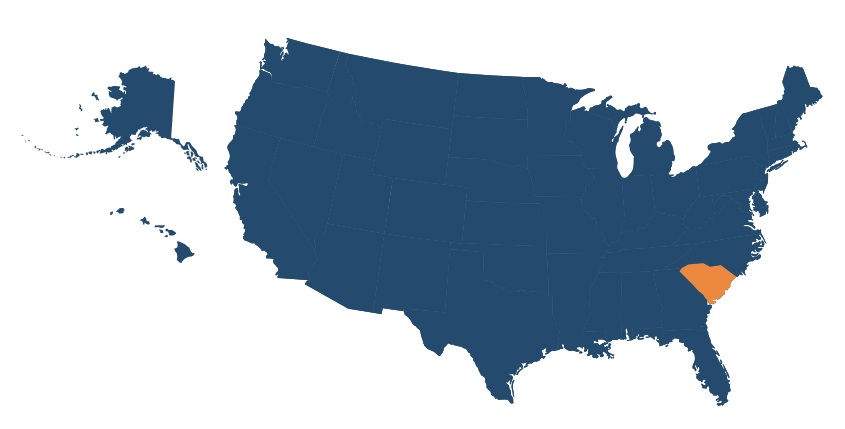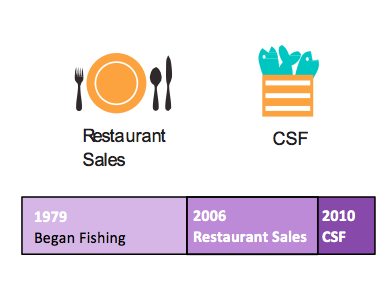A South Carolina Experience: Restaurant Sales & a CSF
Our Story & Insights
Experiences with Seafood Alternative Marketing
Fisheries regulations started changing (Annual Catch Limits were being set for the first time) in the early 2000s, and I realized that there were less fish available in my future, so I needed to figure out how I could make more money with less fish. We started selling to restaurants in 2007-2008 around the same time the South Carolina Aquarium started its Sustainable Seafood Initiative, a program to educate local chefs. The Aquarium folks helped us connect with local chefs and we started selling to restaurants. It worked really well for us.
A few years later, we had a surplus of fish that we couldn’t always sell to the restaurants. We noticed that community supported agriculture was really taking off, so we decided to give a CSF a try. We still sell some of our fish to a commercial buyer, but a majority of our product goes to our CSF and selling directly to restaurants.
We also have been able to sell some underutilized species and create new markets for those species. Before, we would get $0.75/pound from the fish house for fish such as amberjack. The fish is typically considered lower quality for aesthetic reasons. However, the value of fish isn’t reflective of how good it tastes. So because we produce a high quality product, the chefs trust us, and we are offering something new to consumers and chefs, we can now get $8/pound for amberjack.
Challenges with Seafood Alternative Marketing
- Staying organized to effectively manage our customer communications and CSF shares
- Difficulty expanding direct sales to restaurants outside our area due to limited resources, i.e., business infrastructure, staff, time, and delivery costs
- Trying new marketing approaches can be time-consuming; before the CSF I worked 80 hours per week (between fishing, marketing, and delivering) and now it’s close to 120 hours per week
Highlights of Seafood Alternative Marketing Efforts
Our CSF is a fisherman-owned business that provides fresh seafood primarily from our catch. Customers pay quarterly for a share that is delivered on average twice a month. There is no set schedule for providing fish to our customers. We contact them two or three days before the boat comes in with the fish, and let them know when they can come by to pick up their shares dockside. Our customers have been very supportive of this approach.
Flexibility is key; things can be unpredictable for customers and the fishermen. During our first cycle in the CSF, our engine broke down and we were not able to go fishing. I reassured people we were determined to get them their fish, and was amazed by the outpouring of support. We got the engine fixed and were able to provide their fish.
More recently, we could only cover a one-day pick-up instead of our normal two-day pick-up window due in part to weather. Well, everyone came all at once and we had a horrible line, and people had to wait forever. Despite this problem, we only had one or two complaints, but we felt terrible about it. Afterward, I emailed the group to explain why we had only a one-day pick-up and to remind them that a CSF is a different kind of arrangement, where folks need to be willing to bear with some unpredictability along with us. They were so supportive, saying we were doing a great job, waiting was not a problem and it was all part of the experience. That was really eye-opening.
Sometimes it takes a leap of faith to try a new marketing approach, but we thought the options through carefully before doing so.
We need flexibility, so we need to be flexible for our customers. If a customer can’t pick up his share, he can do so the next time. This in turn has been helpful when we need to adjust our delivery schedule. If we didn't have another outlet for our fish, we wouldn't be able to be so flexible.
To figure out pricing, we looked at what fish was selling for locally and offered ours at about half that rate. We went up $1 per pound the next year and another $1 per pound the following year for whole fish. People tell us, “We’ll pay more.”
Notable Quotes
If we weren’t doing a CSF, we would have gone out of business. In a poor economy, we were actually doing ok because of it.
We’ve really developed a community with these people. Our customers have signed up for the whole experience. This is indeed, a community supported fishery.


